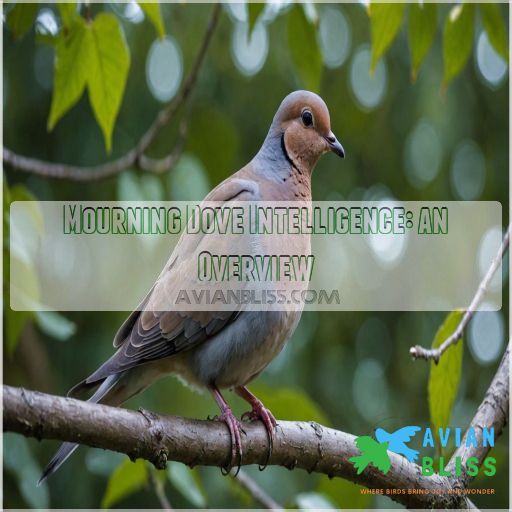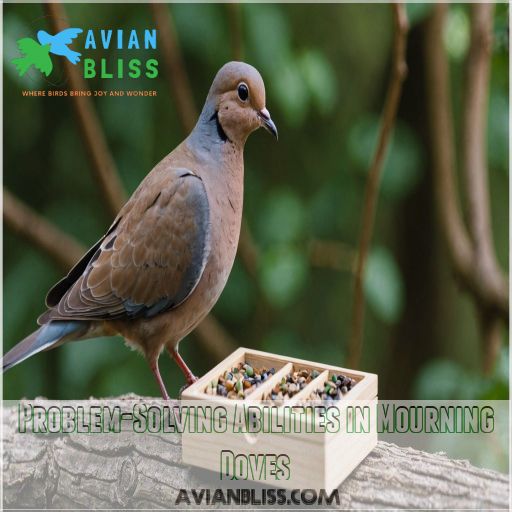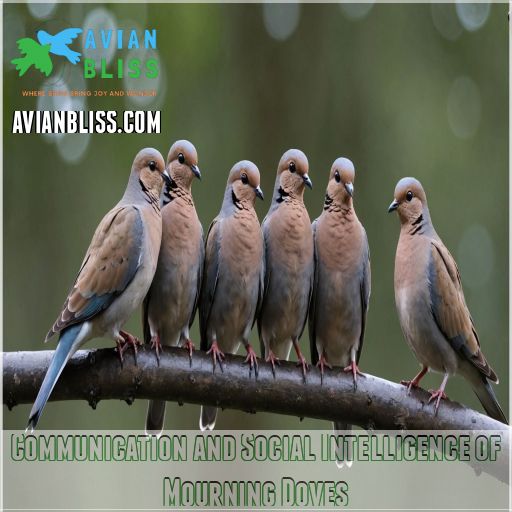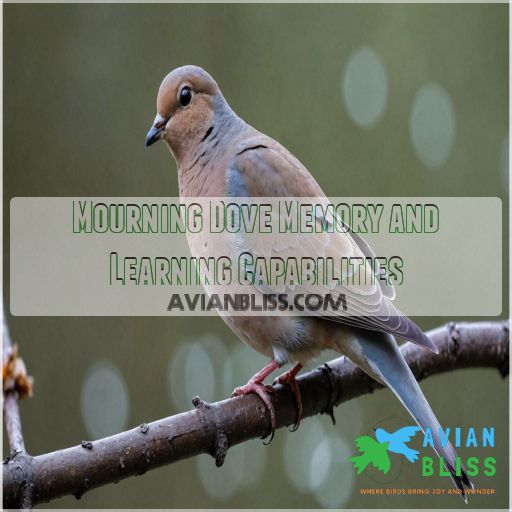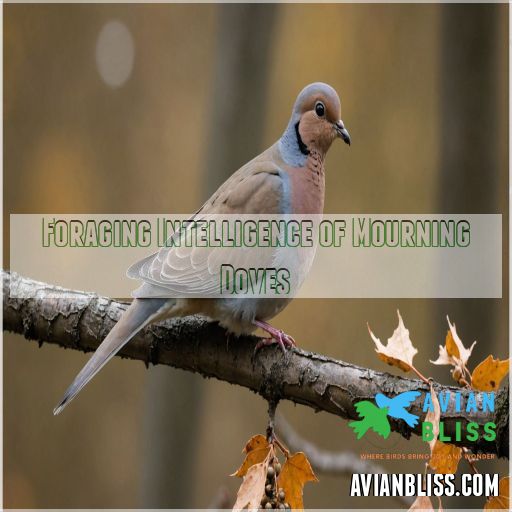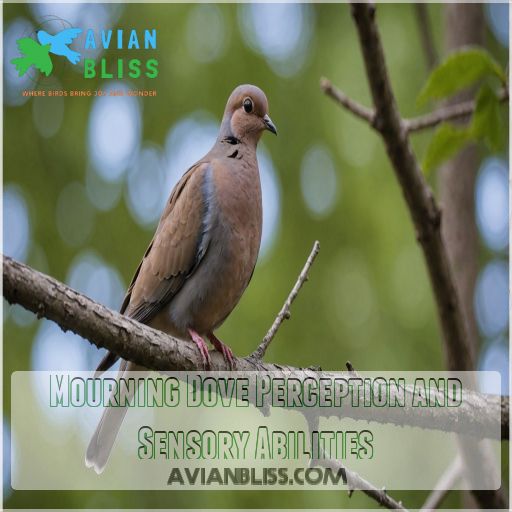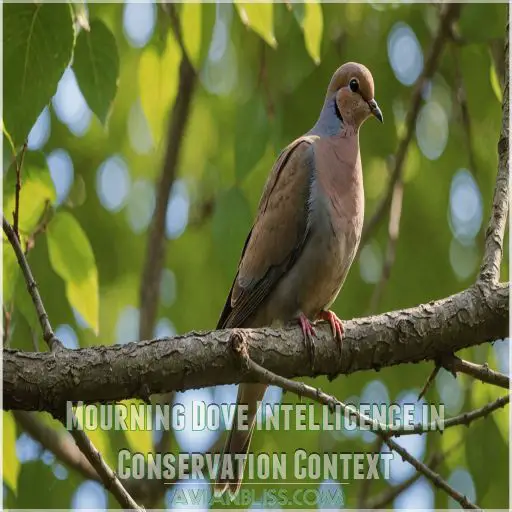This site is supported by our readers. We may earn a commission, at no cost to you, if you purchase through links.
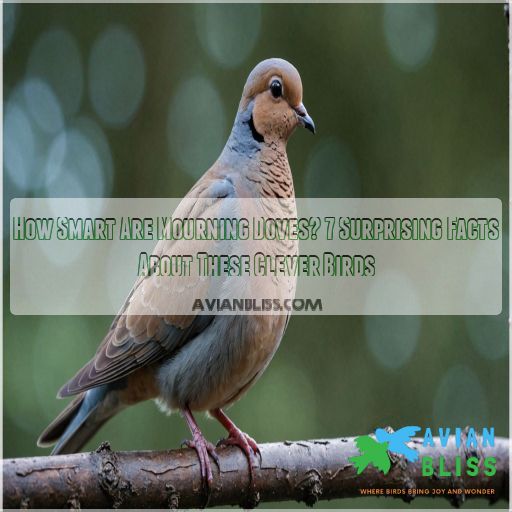 You’d be amazed at how smart mourning doves are! These clever birds have some seriously impressive cognitive abilities.
You’d be amazed at how smart mourning doves are! These clever birds have some seriously impressive cognitive abilities.
For starters, they can remember the locations of food caches with pinpoint precision, thanks to their exceptional spatial memory.
And get this – they even use tools, like twigs, to access hard-to-reach seeds.
But that’s not all – mourning doves are also skilled navigators, using celestial cues like the stars and moon to guide them on long-distance migrations.
Plus, they’re masters of communication, with diverse vocalizations that convey everything from mating rituals to danger alerts.
Mourning doves are truly the brains of the bird world!
Table Of Contents
- Key Takeaways
- Mourning Dove Intelligence: an Overview
- Remarkable Navigation Skills of Mourning Doves
- Problem-Solving Abilities in Mourning Doves
- Communication and Social Intelligence of Mourning Doves
- Mourning Dove Memory and Learning Capabilities
- Defensive Strategies and Territorial Behavior
- Foraging Intelligence of Mourning Doves
- Mourning Dove Perception and Sensory Abilities
- Cognitive Development in Mourning Dove Chicks
- Mourning Dove Intelligence in Conservation Context
- Frequently Asked Questions (FAQs)
- Do doves remember humans?
- Do doves get attached to humans?
- Do mourning doves have feelings?
- Is a dove a smart bird?
- What role does mourning dove intelligence play in mate selection?
- How do mourning doves perceive threats in urban environments?
- What similarities exist between mourning doves and other intelligent bird species?
- How does the social structure of mourning doves affect their intelligence?
- Can mourning dove intelligence contribute to ecosystem balance?
- Conclusion
Key Takeaways
- You’ll be amazed at mourning doves’ impressive spatial memory – they can remember the locations of food caches with pinpoint precision, making them experts at efficient foraging.
- These clever birds are masters of navigation, using celestial cues like stars and the moon to guide them on long-distance migrations spanning thousands of miles.
- Mourning doves are true problem-solvers, using tools like twigs to access hard-to-reach seeds and adapting their foraging strategies to thrive in changing environments.
- With their diverse vocalizations and intricate social behaviors, mourning doves showcase remarkable communication and social intelligence, forming lifelong pair bonds that put some humans to shame, just like pigeons form lifelong bonds.
Mourning Dove Intelligence: an Overview
Mourning doves may seem like unassuming backyard birds, but they possess remarkable cognitive abilities learn more about dove behavior.
From their exceptional navigation skills to their problem-solving prowess, these clever creatures continue to surprise researchers with their intelligence.
Cognitive Abilities in Mourning Doves
Mourning doves are surprisingly brainy—don’t let their gentle coos fool you.
These birds have exceptional spatial memory and problem-solving skills to match.
They recall food locations with ease and recognize predators faster than you’d spot an empty chip bag.
Their avian intelligence includes a social flair, giving them a unique edge.
Comparison to Other Bird Species
Feeling like you’re comparing apples to oranges when looking at mourning doves and pigeons? You’re not alone! Doves, known for their problem-solving and tool use, navigate using celestial cues.
Pigeons, including the passenger pigeon and Eurasian collared dove, excel in homing abilities.
Both birds showcase unique:
- Social behavior
- Language skills
- Adaptive learning
- Sensory perceptions
- Problem-solving techniques
Remarkable Navigation Skills of Mourning Doves
You’ll be amazed at just how smart mourning doves are, especially in terms of their navigation skills.
These doves put road-trippers to shame with their long flights, using a sharp memory and a trusty internal map to find their way!
Long-Distance Migration Capabilities
Remarkably, mourning doves undertake impressive long-distance migrations, traversing thousands of miles with pinpoint precision. Their navigational prowess is truly awe-inspiring, guiding them across continents with remarkable efficiency.
Role of Hippocampus in Spatial Memory
When traveling long distances, mourning doves depend on their hippocampus – much like your brain’s GPS.
With a highly developed hippocampus, these doves master spatial memory, so they know their way home.
It’s like finding your socks in a labyrinth!
Celestial Navigation Techniques
Imagine mourning doves using the sky as their map!
Their celestial navigation skills include:
- Stargazing at night for direction.
- Using the Sun compass in the day.
- Recognizing changes in the Moon phases during bird migration.
No wonder they don’t get lost!
Problem-Solving Abilities in Mourning Doves
You’d be surprised at just how smart mourning doves are in terms of tackling problems in their environment.
From using tools to get food to recognizing which threats to avoid, these doves demonstrate an impressive level of adaptability and intelligence.
Tool Use for Food Access
Utilizing twigs as tools, mourning doves showcase their resourcefulness in accessing hard-to-reach seeds. This ingenious behavior allows them to maximize their calorie intake from diverse food sources.
Twig Tool Use Seed Extraction Adaptability
Adaptability to Changing Environments
Mourning doves have a knack for dealing with life’s curveballs. Their adaptability shines through when facing environmental changes like urban habitat shifts, climate change impacts, food source changes, or pesticide exposure.
These clever birds thrive by:
- Adjusting nesting habits
- Modifying foraging techniques
- Expanding diet choices
- Moving through urban landscapes
- Persisting through weather fluctuations
Recognition of Specific Threats and Food Sources
Just as they cleverly adjust to new environments, these birds excel at recognizing specific threats and food sources.
Their impressive predator-prey interactions demonstrate learned avoidance and threat response.
With food source memory and adaptive foraging, they’re like nature’s own survival strategists.
Communication and Social Intelligence of Mourning Doves
When you hear a mourning dove’s soft coo, you’re eavesdropping on one of nature’s most fascinating communicators.
These birds have a variety of vocalizations with distinct meanings but they also engage in impressive social interactions, forming lifelong pair bonds that could teach us a thing or two about lovebirds.
Diverse Vocalizations and Their Meanings
Mourning doves’ diverse "hoo-hoo" calls convey a range of meanings, from mating rituals to danger alerts. These vocal cues showcase their complex communication skills and social intelligence within the flock, [similar to how ravens use their vocalizations](https://avianbliss.com/can-raven-talk/).
Social Interactions and Flock Behavior
When communicating, these doves showcase intricate social hierarchy and flock dynamics.
With flock sizes that can change like the weather, they use communication signals to coordinate and maintain order.
It’s like nature’s own avian million-dollar secret society!
Mating Rituals and Pair Bonding
Among mourning doves, lovebirds court through displays as theatrical as a Broadway show.
They choose mates with care, build nests together, and share chick-rearing duties, showcasing impressive pair fidelity.
It’s relationship goals—feathered edition!
Mourning Dove Memory and Learning Capabilities
You might be surprised to learn that mourning doves have impressive memory skills, which help them locate food sources and recognize individual humans.
These clever birds have adapted to urban environments, showing they’re street-smart and ready to thrive in bustling city life.
Spatial Memory for Food Sources
Mourning doves excel at remembering where they’ve stashed seeds, thanks to their impressive spatial memory. This helps them efficiently forage and stockpile food, ensuring they’re well-fed even in lean times.
Recognition of Individual Humans
Having a knack for spotting familiar faces, these doves likely recognize you from your backyard adventures.
Witness the bond-growing moments:
- A curious head tilt
- Gentle coos of recognition
- Brave perches nearby
- Playful wing flutters
- Trusting eye contact
Adaptation to Urban Environments
Spotting familiar faces isn’t all they do well. In your bustling city, cities pose unique challenges: noise pollution, human interaction, and predator avoidance.
| Urban Challenges | Dove Strategy |
|---|---|
| Urban food sources | Versatile diet |
| Nest site selection | Architecture savvy |
| Noise pollution | Vocals adjusted |
| Human interaction | Cautious curiosity |
These agile doves adapt intuitively.
Defensive Strategies and Territorial Behavior
You might picture mourning doves as peaceful, but they’re surprisingly skillful in defending their space.
Using a comically named "kung-fu wing slap," these birds assertively guard their feeding spots and nests, proving that they’re more feisty than they first appear.
Kung-Fu Wing Slap Technique
Mourning doves pack a punch with their "kung-fu wing slap" – a fierce defensive move that can deter even larger birds from encroaching on their territory.
This unexpected display of aggression showcases their scrappier side.
Assertiveness in Defending Feeding Spots
While mourning doves may sound timid, they’re surprisingly bold.
Picture a dove kung-fu wing-slapping its way through food competition!
With fierce territorial fights, these birds will defend feeding spots against larger opponents.
Dove vs. dove? Not on their watch!
Nest Protection Strategies
Your backyard friends aren’t just feathered freeloaders; they’re cunning strategists!
With top-tier nest site selection, they outwit predators.
Using nesting materials like twigs and grass, they create sturdy homes, and their parental defense is fierce, shooing off threats effortlessly.
Foraging Intelligence of Mourning Doves
You might see mourning doves pecking around your backyard, but there’s more to their feeding habits than meets the eye.
These clever birds efficiently choose seeds, use their crop for storage, and adapt to various food sources, showing they’ve got brains behind those tiny heads.
Efficient Seed Selection and Consumption
These clever doves know their seeds!
They selectively feast on weed seeds, grains, and wild grasses, showcasing their foraging prowess.
Their adaptability shines as they outcompete larger birds at feeding spots.
Crop Storage for Later Digestion
Mourning doves boast a quirky skill: crop storage. They stockpile seeds in their esophagus, like saving snacks for later.
This clever tactic helps with digestive efficiency during food scarcity.
It’s nature’s little pantry trick of bird behavior, helping with survival.
Adaptation to Various Food Sources
Balancing their crop storage with varied seed preferences, these feathered opportunists show astounding diet flexibility.
Their foraging strategies morph like clay in food competition settings, enabling them to munch on everything from tiny weed seeds to chunky shelled peanuts effortlessly.
Mourning Dove Perception and Sensory Abilities
You might be surprised to learn that mourning doves are wiser than they look, with sharply honed senses that keep them on their toes.
Their keen vision detects predators from afar, their ears pick up subtle sounds, and they’ve a refined touch for finding food, making them the Sherlock Holmes of the bird world.
Visual Acuity for Predator Detection
Mourning doves’ keen eyesight allows them to spot predators from afar, thanks to their sharp vision and ability to detect subtle movements.
Camouflaged plumage helps them blend seamlessly into their surroundings, a clever defense against aerial threats.
Auditory Capabilities for Communication
While their visual skills help spot predators, the doves’ communication shines like morning sunbeams.
You’ve likely heard those mournful coos.
Their calls show sound recognition and acoustic communication, a bit like vocal learning maestros, mastering sound localization seamlessly.
Tactile Sensing in Foraging
Imagine you’re a mourning dove.
Your beak and feet are like finely tuned instruments, sensing seed texture with astounding precision.
This tactile perception transforms foraging into a skillful dance, enhancing your foraging efficiency.
Who knew beaks and feet could be so talented?
Cognitive Development in Mourning Dove Chicks
In the world of raising smart chicks, mourning doves are like the doting parents of the bird world.
You’ll catch these devoted avian mums and dads teaching their young critical survival skills,
ensuring they’re ready to navigate the world on their own.
Early Learning and Imprinting
Mourning dove chicks are quick learners, soaking up parental guidance during a critical period of imprinting. From vocalizations to nest-building, these feathered youngsters rapidly acquire essential survival skills for life.
Acquisition of Survival Skills
You might think of mourning dove chicks as little feathered sponges, soaking up survival skills like predator avoidance and food gathering.
As they grow, they master nest building and chick rearing, eventually facing the challenge of winter survival.
Parental Teaching Behaviors
As chicks acquire survival skills, they learn important lessons from their parents:
- Nest-building skills: Watch and mimic to create a sturdy home.
- Chick feeding tactics: Master efficient digestion.
- Predator warnings: Understand and react swiftly.
These promote foraging lessons and fledgling independence.
Mourning Dove Intelligence in Conservation Context
You might not think of mourning doves as environmental superheroes, but these birds are quietly adapting to habitat changes and playing a key role in ecosystem management.
Mourning doves‘ surprising adaptability and response to conservation efforts make them essential allies in maintaining biodiversity.
Adaptability to Habitat Changes
You’ll be amazed by how quickly mourning doves adapt to urban sprawl, shifting nest sites and food sources to thrive.
Even as climate change and predators pose new challenges, their resilience is truly remarkable.
Response to Conservation Efforts
Imagine life as a mourning dove, gliding through changing landscapes.
Population trends in habitat restoration, hunting regulations, and predator control are like nature’s rollercoaster.
Climate change impacts your journey, but your adaptability shines brightly, a reflection of resilience in nature’s chaos.
Importance in Ecosystem Management
Mourning doves are nature’s gardeners. They play a role in ecosystem management through:
- Weed control: Eating pesky seeds like they’re popcorn.
- Seed dispersal: Spreading plant joy.
- Predator-prey balance: Keeping things lively.
- Habitat indicators: Signaling environmental health.
Frequently Asked Questions (FAQs)
Do doves remember humans?
Picture a timid bird spotting you from afar.
While there’s no evidence mourning doves remember specific humans, their sharp spatial memory and predator recognition might just mean they’re keeping a keen eye on any potential threat.
Do doves get attached to humans?
Doves don’t form deep attachments to humans like some pet birds.
They’re generally more focused on their survival instincts.
Still, with regular, gentle interaction, they might tolerate your presence, appreciating you as a harmless seed-supplier!
Do mourning doves have feelings?
You bet your tail feathers these birds have feelings!
They may seem like a bunch of couch potatoes, but mourning doves are surprisingly savvy, using tools and recognizing threats.
Don’t underestimate their emotional intelligence – they’re more than just a pretty face!
Is a dove a smart bird?
When considering avian intelligence, a dove’s savvy shines.
Those feathered friends exhibit problem-solving, robust memories, and nuanced communication.
Although they might not rival avian Einsteins like crows, doves prove surprisingly sharp for their niche.
What role does mourning dove intelligence play in mate selection?
Mourning dove intelligence plays a charming duet in mate selection.
Their problem-solving skills and navigation prowess woo potential mates by showing resilience and adaptability, akin to impressing with a clever dance move and a winning smile.
How do mourning doves perceive threats in urban environments?
Ever wonder how mourning doves outsmart city life?
These birds don’t just wing it; they identify urban threats by recognizing consistent predators and adjusting their escape routes, sometimes even using cars as temporary cover.
Smart, right?
What similarities exist between mourning doves and other intelligent bird species?
You’ll be amazed at how mourning doves stack up against other brainy birds.
Like pigeons, they excel at navigation and problem-solving, showcasing impressive cognitive abilities that might just surprise you.
It’s a real avian intelligence showdown!
How does the social structure of mourning doves affect their intelligence?
Think of a mourning dove as the shy student quietly acing exams.
Their social structure is subtle yet cooperative, fostering navigation and problem-solving skills necessary for survival—a delicate dance between timid appearance and underlying intelligence.
Can mourning dove intelligence contribute to ecosystem balance?
Mourning dove intelligence helps keep ecosystems in check.
Their knack for seed dispersal, problem-solving against predators, and unique migration navigation maintain ecological balance, promoting plant diversity and acting as both prey and predator in their environment.
Conclusion
Imagine spotting a mourning dove expertly maneuvering a busy cityscape, dodging traffic with remarkable ease—these birds truly showcase a hidden intellect.
Now you know how smart mourning doves are.
From their impeccable memory for locating food to their celestial navigation skills, mourning doves demonstrate fascinating cognitive prowess.
They’re not just pretty faces; they’re resilient and adaptable survivors, balancing intelligence and instinct.
Next time you spot one, give a nod to its brainy brilliance.

